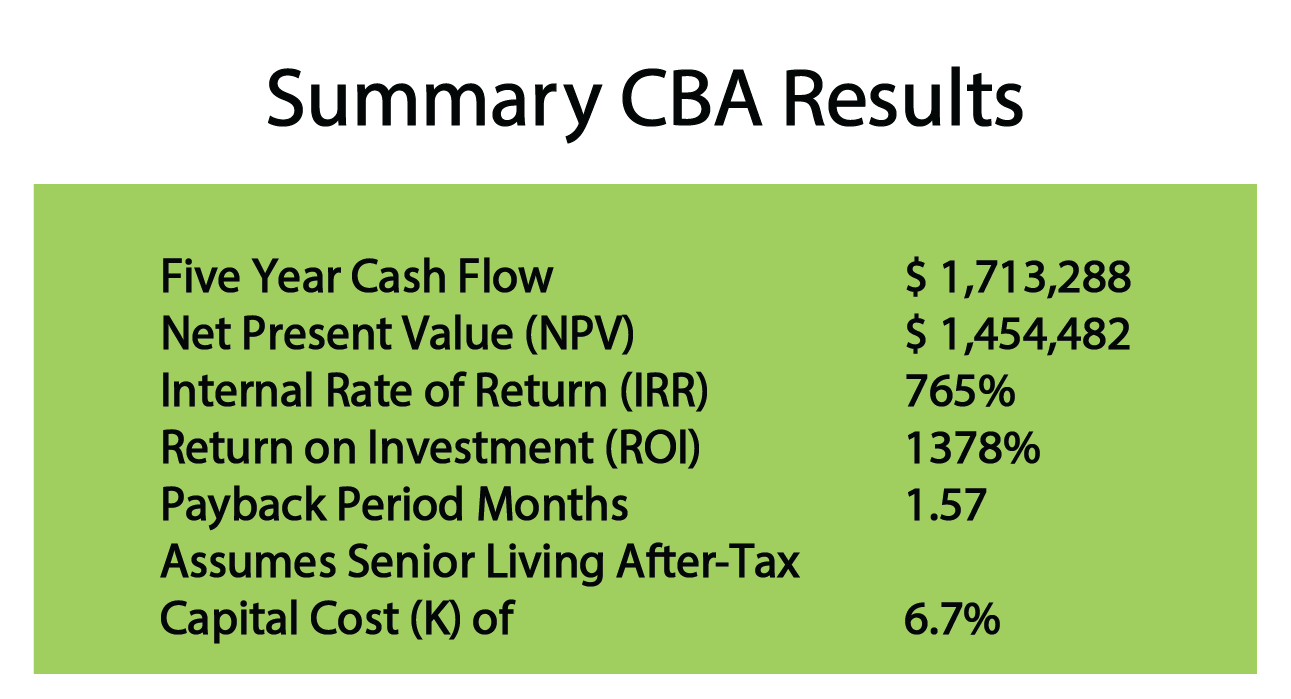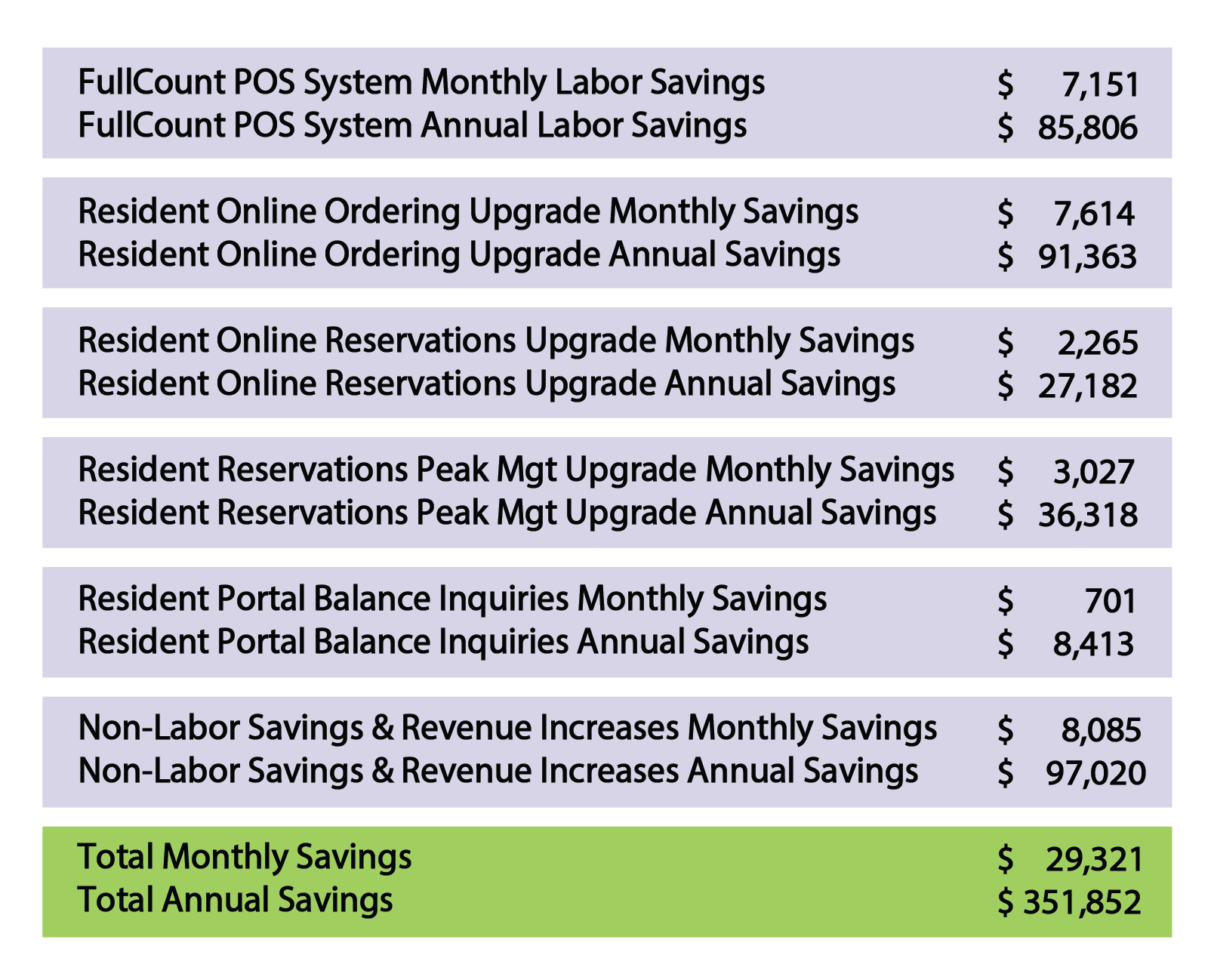FullCount Senior Living Point of Sale (POS) System
Cost Benefit Analysis
FullCount POS System vs Non-Senior Living POS System

Free Cost Benefit Calculator. Just Seconds to See How Much You Will Save!
Below is a detailed analysis of the costs, dollar value savings and returns experienced by a typical Senior Living community with Independent Living which has deployed the FullCount POS system.
In this Cost Benefit Analysis (CBA), we calculated the costs and benefits based on an average sized FullCount community with a typical deployment configuration which includes the foundational FullCount system with upgrades including Resident-enabled Online Ordering, Reservations and Portal as well as our Accounting Admits/Discharges/Transfers Upgrade.
Additionally, Online Ordering, Reservations and Portal resident usage rates are based on typical community usage penetration rates after one year based on internal FullCount anonymized data. Most communities experience higher resident participation rates for Online Ordering, Reservations and Portal upgrades as a percentage of total resident census over time. This would indicate higher economic benefits than estimated, but Year 1 resident usage penetration rates are extrapolated throughout the five year estimate of the CBA for modeling reliability purposes.
EXECUTIVE SUMMARY:
You’ll notice immediately the impacts of a Senior Living Point Of Sale (POS) system vs a Non-Senior Living POS system are dramatic and atypical of most software deployments and investments.
The reasons for this are threefold:
The intricacies of managing various aspects of accounting, taxation and billing in Senior Living are unique and significant. What we typically see with prospective customers using an Off-The-Shelf (OTS) Senior Living POS is that they are forced regularly to do
- Manual data calculations and categorizations of transactions (even bifurcating within specific meals or purchase events),
- Manual calculations and data entering into their accounting system of transactions or summaries and
- Individualized billing reconciliations and balance inquiries. FullCount’s system eliminates most of this drudgery and automates the process of categorizations, data uploads and integration and billing system inputs.
The intricacies of managing various aspects of meal plans, health monitoring and menu rotations. Prospective customers of the FullCount system usually deal with:
- Multiple meal plans and nuances within those meal plans. The calculations of these meal plan variances and entries is manually intensive and time consuming if the system is not designed for the particularities of Senior Living.
- Additionally, health monitoring of nutritional consumption and allergy alerts are rarely available in an OTS POS system. Often resulting in “ingredient checks” by staff with the kitchen (or worse, not warning of ingredients) which cost time and undermine the resident experience.
- Menu rotations are critical with a captive dining audience. OTS systems are not designed for easy, fast menu rotations Or (often not) designed for scheduled, pre-programmed menu changes. The FullCount system is.
The benefits of redirecting a captive audience to online options. Prospective customers of the FullCount system sell to a captive audience with known technology resources:
- In the last two years, FullCount has seen an explosion in the enablement of remote technologies for residents.
- Online Ordering (in a labor shortage world) cuts labor needs and facilitates resident convenience.
- The FullCount portal and reservation system also reduce labor usage in accounting and dining respectively. The reservation system can also smooth peak labor usage by elongating available dining times.
The primary driver in most of the definable economic value of the FullCount POS system vs a OTS POS system lies in reduced labor usage.
Senior Living now, and more so in the future due to demographic trends, faces a labor shortage.
The FullCount system, based on this analysis, provides significant labor savings in additional labor efficiency (accounting and dining staff) as well as reduced labor usage (dining staff) through automation.
KEY FACTORS IN THIS ANALYSIS WERE:
Average Community Resident Size: 308
Community Deployment of:
- FullCount POS System
- Resident Online Ordering Upgrade
- Resident Portal Upgrade
- Resident Portal Reservations Upgrade
- Automated Admits/Transfers Upgrade

All labor cost allocations are fully loaded with typical company benefits and support costs and based on independent third-party estimates as shown below in the External Sources section.

| External Sources: |
| https://www.chefhero.com/blog/restaurant-turnover-rate |
| https://www.indeed.com/cmp/Sunrise-Senior-Living/salaries/Controller |
| https://www.glassdoor.com/Salary/Sunrise-Senior-Living-Dining-Services-Director-Salaries-E6023_D_KO22,46.htm |
| https://www.pymnts.com/news/retail/2018/mcdonalds-earnings-kiosk-delivery/ |
| Internal Sources: |
| FullCount anonymized data was compiled from residents’ sample sets and overall resident data |
